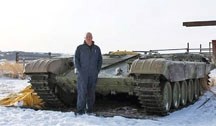A Priddis firefighter believes he has a solution to fight major wildfires that could help prevent disasters like last year’s devastating blaze in Slave Lake.
Jason Eastwood, president of E2 Logistic Solutions Inc., is developing an all-terrain firefighting vehicle built on top of a Russian tank to bring specially designed water containers into the middle of a fire to be operated by remote from a safe location. All the while firefighters operating the vehicle are protected in a safe environment.
“This machine could go right into a forest fire without killing the operators inside,” said Eastwood. “I figured there had to be a better way.”
The Red Deer Lake area resident is a volunteer firefighter with the Priddis Fire Department who first started fighting forest fires in B.C. almost 25 years ago, eventually becoming a crew boss.
Eastwood said his new system is intended to put up a barrier of water between a fire and anything in its path, be it a building or a forest.
The problem with other wildfire vehicles, he said, is some models have tires that can be compromised by intense heat, while others don’t have sealed cabs exposing firefighters to heat and smoke.
His vehicle is built on the chassis of a Russian T72 battle tank, which had the gun turret and other weapons removed before being shipped to Canada. The track-based vehicle would be capable of moving through rough terrain to get to hard to access areas and can travel as fast as 70 km per hour.
The tank has a hermetically sealed cab and is designed to operate in chemical, biological and nuclear warfare conditions. He said it is fully capable of operating in forest fires where temperatures can reach upwards of 1,300 degrees Celsius.
Eastwood is also developing special water containers that can be moved into fires with the tanks or other vehicles.
The containers would spray water and it will include a foam system to be combined with water. A smaller 20-foot long container would be able to carry 4,500 gallons of water, while a 40-foot long container would be able to carry as much as 15,000 gallons. The tank carries the smaller containers and the larger ones would be pulled into place on a trailer.
The modules are based on shipping containers, which have standardized dimensions and can be moved into position by a variety of different modes of transportation including trailers, helicopters or by rail.
Eastwood took his vehicle to the CBC series Dragons Den looking for financial backers for the system where it was criticized by one of the show’s business gurus.
“Five minutes in Kevin O’leary (O’Leary??) starts yelling and screaming at me and telling me ‘unless this thing can fly it’s a complete waste of time,’” he said.
However, he countered this criticism saying fighting a fire by air is inefficient and risky to pilots.
“The fire creates such a force that the wind speed can pull a plane right into the ground,” he said.
Eastwood said the water containers cost about $200,000 for the smaller models and $350,000 for the larger ones and are designed for an international market.
The tank-based vehicle costs approximately $750,000 to modify, import and have ready to use. The tanks themselves come with a hefty $1 million price tag, but he said the actual costs are closer to $300,000 to $350,000 after the military components are removed overseas and resold.
Eastwood doesn’t plan to sell the tank-based carriers and he will lease them out instead.
He said the cost is worth it when battling fires such as the one in Slave Lake which caused more than $1 billion in damage.
Eastwood has a number of advisors on the project, including University of Calgary business professor Robert Schultz and MD of Foothills Fire Chief Jim Smith.
Smith called it a groundbreaking project for firefighting and the use of remote technologies in this area. He said the system has great potential to be effective in fighting wildfires.
“Looking at this project, it’s a glimpse into the future to what it can hold for firefighting, especially from a firefighter safety point of view,” he said.
Smith is providing advice and assistance from the fire fighting perspective. He was a mechanic on tanks and other armoured vehicles while he was a member of the armed forces and he is able to bring his experience in this area to the project to help with maintenance and fabrication work on the tank chassis.
Smith said the system will require a shift in mind set on how to approach a fire.
“When it comes to different thought processes it may take a short time or a long time based on past products and also past ways of doing things in firefighting,” he said. “It may be a change tactics and strategies.”




